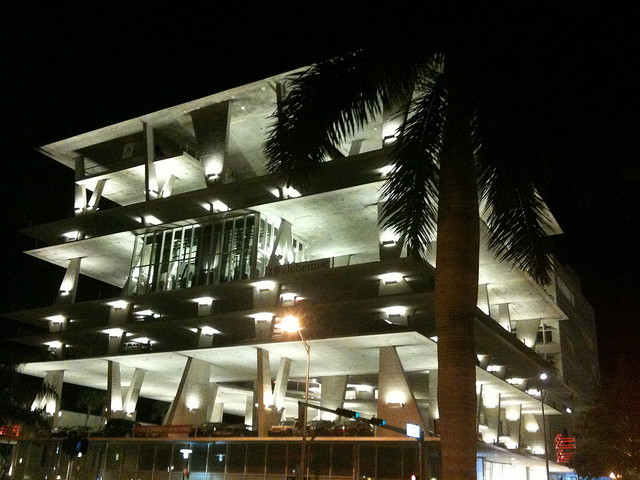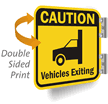Can a parking garage be intellectual property?
11 11 Lincoln Road, at night. Licensed under Creative Commons, some rights reserved; photo by miamism.
Here at parkingsigns.net, we think a lot about how parking works, from the economics and urban planning aspects to the environmental impact, cost recovery and municipal fine structures. We were caught off-guard this week when a news item alerted us to a new dimension that we’d never even thought about: parking as intellectual property.
Photographer Hester Esquinazi was in a state of intoxication in a much-ballyhooed Miami parking garage, 11 11 Lincoln Road, and was inspired to snap a bunch of photos from inside the garage, way back in 2010. She assembled them as part of a show, and was promptly issued a licensing letter by UIA Management, who are enforcing their intellectual property rights. (UIA Management, LLC is owned by Robert Wennett, the Miami property developer who owns the garage – it’s not a garage management company, even if it does sound like one).
This prompts a few questions:
- For an open structure like 11 11 Lincoln Road, where does the line get drawn between license and fair use? The structure doesn’t have walls separating it from onlookers or the elements; it’s so permeable that some motorists have complained that it doesn’t prevent their cars from being rained on. Is the difference between a cease-and-desist order and the photos that anyone is allowed to take (and sell) really based on where the photographer is standing when she snaps her photos?
- What provisions of intellectual property law is UIA using to enforce its license in the first place? Copyright law is notoriously knotty to begin with, and even more so when it comes to architecture.
According to the American Institute of Architecture’s Best Practices guidance on the subject, published in 2006, the Architectural Works Copyright Protection Act of 1990 applies to “the design of a building as embodied in any tangible medium of expression, including a building, architectural plans, or drawings.” The extent to which images of a building’s appearance constitutes fair use hasn’t been extensively litigated, and begs the question: are tourists who photograph the New York City skyline and publish at a profit opening themselves up to lawsuit from thousands of property owners?
- What hypothetical is UIA management trying to prevent? Is it worried that someone else might steal its design features, which are already visible to all since the garage literally has no walls? Are there features only evident up close that it’s worried some other architect might cadge (even though the garage is famously open to joggers and passersby to mosey through)?
- There have been plenty of photos of the property posted online. Is it sure that none of the non-Creative Commons-licensed photos of 11 11 Lincoln haven’t been sold at a profit, and if not, when does it plan to start enforcing its IP rights on Flickr and in the many other for a where the property has appeared? Or is there some undisclosed quality that made Ms. Esquinazi’s photos peculiar?
It’s hard to think of a better subject for a still life than architecture – it’s unlikely to jiggle or strike a bad pose, and most buildings that aren’t big box stores include at least the occasional nod to ornamentation.
An interior of 11 11 Lincoln Road, published under Creative Commons by mark.hogan.
Although we can’t expect parking garages as attractive (and expensive) as 11 11 Lincoln Road to spring up everywhere, we do appreciate Pritzker winners Herzog and De Meuron dignifying parking with their careful design and the same bold ingenuity that they put into practice with Beijing’s famous “bird’s nest” stadium. Turning the property into a fulcrum upon which to rest a $7,500 licensing fee seems petty compared with the place’s gargantuan price tag – and having completed the garage, we can’t help wishing Mr. Wennett would just rest on his laurels a little.
From a sign perspective, the curious case has prompted a little soul-searching hereabouts. Should we be issuing cease-and-desists to anyone who photographs our signs?
-C. Lumm
Related Posts
Category: News, Regulations






















